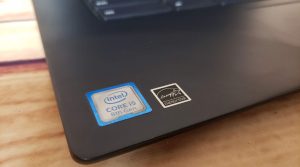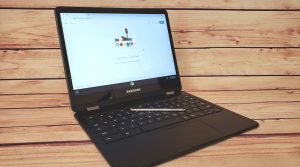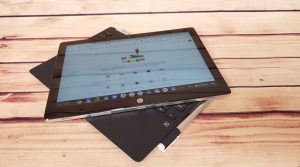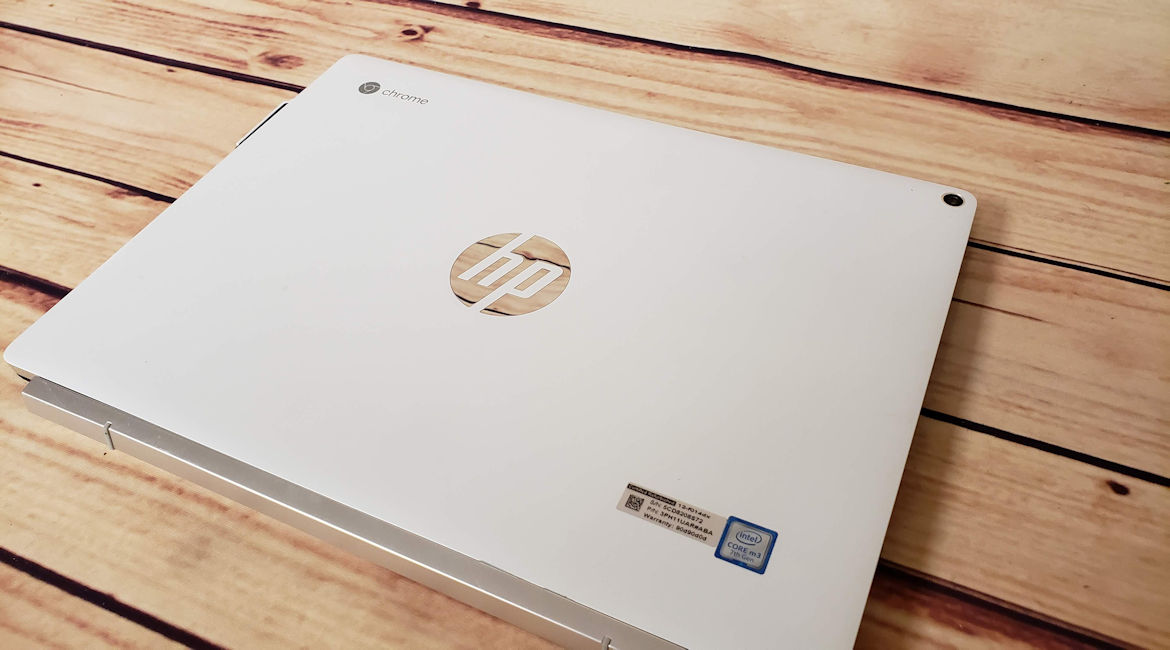In my last article wrapping up computing options for homeschoolers, I mentioned that my platform of choice, at least as a starting point, would be Chromebooks and Chrome OS. I’d like to add a little meat to those bones and help you pick something that’s going to get them going and help keep them going for at least a few years.
I put myself to the task of picking the hardware for the first computer class. Our students ages range from 7 to 14 which make things a bit of a challenge. Additionally, I wanted to find equipment that would not be frustratingly slow right out of the box, but rather robust enough to provide a solid learning experience while still being affordable for a class of 7.
Now there’s a lot of technical things to consider when looking at Chromebooks, most of which will make your head spin until you get what’s happening. Chromebooks run from about $100 to well over $1600+ on the high end. The tendency when looking at hardware for children is to go for the least expensive option. I strongly recommend not going that route because you may wind up paying more in the end. Additionally, you may find that the subpar performance of the low-end units just don’t cut the mustard. So how do you balance budget, performance, and the needs of your homeschoolers?
Here’s a short guide.
Performance starts with the processor and not all processors are created equal, not by a long shot. Moreover, their numbers and names make them even harder to understand. Fortunately Chromebooks don’t really need a lot of horsepower to be great machines. For the most bang for the buck, look for a Chromebook that has an Intel Processor, preferably one of the “core i” processors. You will hear these referred to as Intel Core i7, or  i5 or i3. These will sit at the top of the performance chart and deliver great performance across the multitude of apps that you can throw at them. They are also some of the most expensive starting around $500+ for thusly equipped Chromebooks. One of the better options would be the HP x360 14” Chromebook that’s powered by an i3 processor, has 8 gigs of RAM and 64 GBs of storage. This may be one of the more perfect blends of specs out there currently. I happen to be writing this article on that exact model which I found open box at my local Best Buy for under $400 – a steal given the regular retail price of $600. While the Intel Core i series is the one to get if you can, you can also downshift a bit to the Intel Mobile series and also the dual core Celeron series chips, but that’s as far down as I’d look.
i5 or i3. These will sit at the top of the performance chart and deliver great performance across the multitude of apps that you can throw at them. They are also some of the most expensive starting around $500+ for thusly equipped Chromebooks. One of the better options would be the HP x360 14” Chromebook that’s powered by an i3 processor, has 8 gigs of RAM and 64 GBs of storage. This may be one of the more perfect blends of specs out there currently. I happen to be writing this article on that exact model which I found open box at my local Best Buy for under $400 – a steal given the regular retail price of $600. While the Intel Core i series is the one to get if you can, you can also downshift a bit to the Intel Mobile series and also the dual core Celeron series chips, but that’s as far down as I’d look.
The next major component is going to be RAM. RAM is what you need to run multiple things at once. 4 Gigs is my minimum spec. There are some great Chromebooks that run really well with just 4 Gigs of RAM. My last article was written on a Samsung Plus V2 running an Intel m3 processor, 4 Gigs or RAM, and 64 GBs of storage. I only noticed a hit in the performance when I had a LOT of apps running at once with multiple browser tabs open. In other words, it did great under my heavy loads. It was also about the $500 price point on sale at Best Buy. It’s a dynamite piece of gear that I enjoy working on without reservation, especially the keyboard and trackpad.
While 4 GBs seems adequate now, I can see where it may not be enough as Chromebooks begin to take on a bigger role in business and more apps become available for them. I prefer 8 Gigs of RAM, or more if possible. 8 Gigs is a luxury in a Chromebook and 16 Gigs of RAM is an extravagance. Yes, I have a Chromebook with 16 Gigs of RAM… We’ll talk about that at the end of the article. When picking your gear, look for 4 Gigs of RAM at a minimum and if you can get more, do it. You’ll be very happy you did. This HP x360 that I’m working on, the Lenovo C630, and the Google Pixelbook are the only readily available options with 8 Gigs of RAM. The options for 16 GB units are equally slim.
Next, there’s the question of how much storage is the right amount of storage. Well, this gets a bit muddy. In the PC or Mac world, we look at storage in Terabytes (TB), or in other words, 1000 Gigabytes. You just don’t need that for Chromebooks. Think of Chromebooks more like really functional cell phones. Do you need 1TB of storage on your phone? Everything is backed up to google photos, or Amazon photos, Dropbox, OneDrive, or some other cloud storage system. Your phone becomes the interface to capture, transmit and store, and subsequently retrieve data. We all may keep some critical data locally on our phones, but the bulk of it is online and we can get it multiple ways. At this time, my personal minimal spec is 64 GB, and that may change as Chrome OS evolves. I hope it does not go the way of bloatware and sloppy coding. With 64 Gigs as a starting point, and all my apps loaded, I’m sitting with about 38 GBs free for temporary storage while things are getting shuffled up to the cloud in the background, which is more than sufficient right now.
 The last thing to consider is the screen. This, along with the CPU, is what’s going to have the largest impact on the bottom line price. At a minimum you want something that’s touch screen with HD resolution. Now don’t get confused with HD (1280×720) vs FHD (1920×1080) vs QHD (2560×1440) vs UFHD (4K – 3840×2160). For you math folks out there, QHD is 4 times as sharp as HD and UFHD is 4 times as sharp as FHD. When you take and make something 4 times as sharp in the same footprint, then the dots (pixels) get really small. So small that your naked eye can’t see them, and this is a good thing.
The last thing to consider is the screen. This, along with the CPU, is what’s going to have the largest impact on the bottom line price. At a minimum you want something that’s touch screen with HD resolution. Now don’t get confused with HD (1280×720) vs FHD (1920×1080) vs QHD (2560×1440) vs UFHD (4K – 3840×2160). For you math folks out there, QHD is 4 times as sharp as HD and UFHD is 4 times as sharp as FHD. When you take and make something 4 times as sharp in the same footprint, then the dots (pixels) get really small. So small that your naked eye can’t see them, and this is a good thing.
So think of these as all classes of resolution and for this exercise we’ll equate that to “sharpness.” HD is OK… UFHD is, well, awesome. At this time, there is only one UFHD Chromebook being presented (or scheduled to be presented) to the market and it’s going to tip the $1000 price point. In reality, a touchscreen LED HD display is plenty for students who may not know the difference. If you are a serious computer user and you want clean, crisp type, photos, videos, etc, the FHD is your starting point with QHD being the sweet spot for a really nice display.
Resolution is not the only consideration. The type of display is also important. On the low end you’ll have simple LED backlit displays that are just fine as long as the viewing angle is perfect and the lighting conditions are optimal, i.e. indoors with good light. All your low end Chromebooks come with this type of display and they are usually quite adequate at the student level. If you want something brighter, sharper, cleaner, and looking great at all angles, then you want an IPS display which is vastly superior to look at in every respect. The reason that I picked up this HP X360 off the open box rack was in large part for the display. It’s extremely comfortable to view and very bright as well, which for me is important not having great eyesight to begin with.
Final considerations…
Before I get to the final choice for the class, there is one other caveat that I want to discuss which is less about student Chromebooks and a lot more about what may be important to you if you are also looking into getting a Chromebook to work alongside your youngsters. The array of inputs and their build quality/durability really makes a big difference. The keyboard is, for me, the most critical element after the display. The best keyboard I’ve found for my taste is on the Samsung Plus V2. It’s just awesome to type on: solid as a rock, good key travel and feedback, spacious, etc. Next is the Google Pixelbook line which starts at around $800 to $1000 and goes upwards of $1400 to $1700, depending on what deal you can find. Some would argue that the Pixelbook has a better keyboard. I’d tip my hat to them because it is awesome. I just personally prefer the keyboard on the Samsung Plus V2 more. The Google Pixelbook is really at the highest level of engineering when it comes to Chrome OS devices. After the keyboard there’s the trackpad, touchscreen, and pen input which is available on some models. All these play a role in what may make one model better than another for you and your homeschoolers. I have a stable of test units at this point and have tested several in the store. If you have a particular question, just email us from out contact us page and I’ll be happy to help out!
Now, let’s get back to the point of this article and get to what I picked for our first computer class here at Grace Ranch. I picked the HP 14” touchscreen (HD LED Class) with Intel Dual Core Celeron processor, 4 gigs of RAM, and 32 GBs of storage. The price, $260 each on sale. The keyboard and trackpad are decent but not stellar and the performance is solid for students at their level. These should last several years and remain relatively functional. As they outgrow them, we can move them to more appropriate hardware and recycle these back down the chain for new students.
 On a side note, I’ve done a TON of research and have purchased a lot of different Chromebooks while doing so. Each one has its really strong points and some have some glaring weaknesses. You just don’t get the full story from reviewers online for some reason, so this was really the only way to truly know. Maybe I’ll do another article listing each with their benefits, price brackets (new and used), and best scenario uses. I mentioned the Google Pixel book earlier in this article. I do have the top of the top end, the Intel Core i7, 16 GB RAM, 512 GB Storage, QHD IPS Class Display, nearly perfect keyboard and trackpad, Google pen, etc. (purchased 2nd hand on ebay for just over $1000 vs $1700 retail. I.e. you don’t have to buy new to get a great product). It basically goes with me everywhere. It’s microscopically lightweight, all aluminum and glass, and just blisteringly fast. I’ve grown accustomed to “instant” computing where I don’t have to wait for the machine to catch up to me. Chrome OS has made that possible. Consider this. The top of the line Chrome OS devices sit at a fraction of the cost of a top of the line system from the Mac or PC world. So unless you NEED something PC or MAC specific, Chromebooks are just a great choice.
On a side note, I’ve done a TON of research and have purchased a lot of different Chromebooks while doing so. Each one has its really strong points and some have some glaring weaknesses. You just don’t get the full story from reviewers online for some reason, so this was really the only way to truly know. Maybe I’ll do another article listing each with their benefits, price brackets (new and used), and best scenario uses. I mentioned the Google Pixel book earlier in this article. I do have the top of the top end, the Intel Core i7, 16 GB RAM, 512 GB Storage, QHD IPS Class Display, nearly perfect keyboard and trackpad, Google pen, etc. (purchased 2nd hand on ebay for just over $1000 vs $1700 retail. I.e. you don’t have to buy new to get a great product). It basically goes with me everywhere. It’s microscopically lightweight, all aluminum and glass, and just blisteringly fast. I’ve grown accustomed to “instant” computing where I don’t have to wait for the machine to catch up to me. Chrome OS has made that possible. Consider this. The top of the line Chrome OS devices sit at a fraction of the cost of a top of the line system from the Mac or PC world. So unless you NEED something PC or MAC specific, Chromebooks are just a great choice.
Please be sure to visit our Computing Class here on our site! You can watch the videos and learn right along with us!
By Rick Eutsler, Jr




